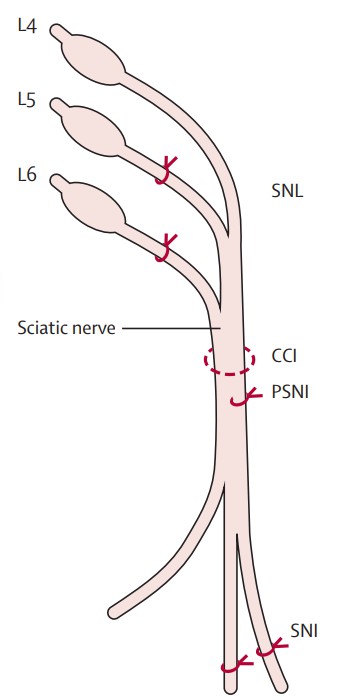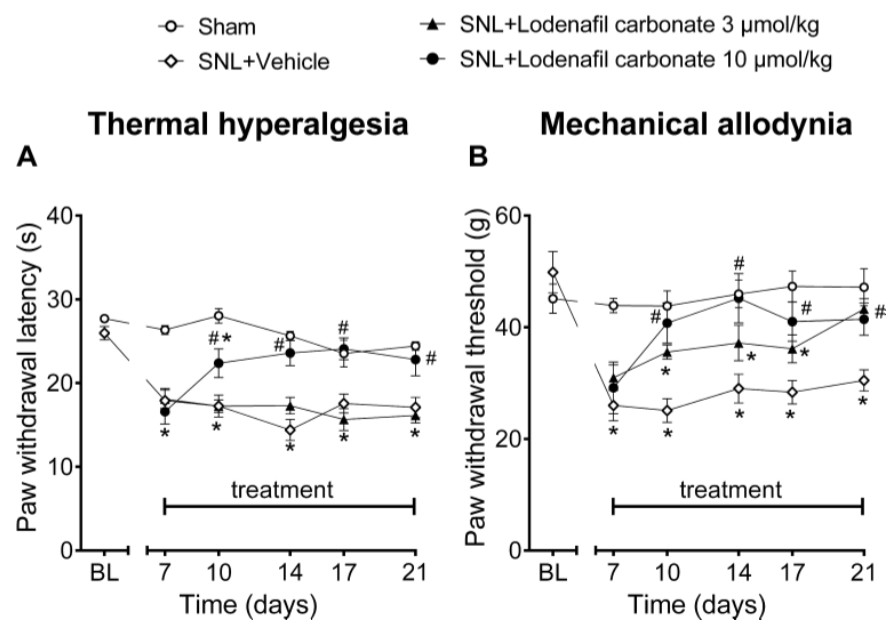Spinal Nerve Ligation (SNL) Model
Creative Bioarray is a pioneering company that specializes in providing cutting-edge preclinical models for pain research. We have established the spinal nerve ligation (SNL) model, a widely recognized neuropathic pain model that simulates chronic pain conditions in rodents. We complement this model with a comprehensive suite of outcome measures, including behavioral tests and biomarker analyses. These tools enable researchers to thoroughly investigate potential drug candidates.
SNL, a well-established model of neuropathic pain, is induced by tightly ligating spinal nerves. In this peripheral neuropathy model, the L5 and L6 spinal nerves are isolated and can be tightly ligated using surgical silk. This leads to axonal degeneration, affecting all types of axons approximately equally. Subsequently, pronounced mechanical allodynia ensues, accompanied by spontaneous pain behaviors and cold allodynia, persisting for months without recovery. This model provides a controlled environment for researchers to explore the underlying mechanisms of pain and to evaluate the efficacy of potential therapeutic interventions aimed at alleviating this debilitating condition.
 Fig. 1 Traumatic nerve injury models used in rodents. (Calvo et al. 2012)
Fig. 1 Traumatic nerve injury models used in rodents. (Calvo et al. 2012)
Our Spinal Nerve Ligation (SNL) Model
- Available Animal
- Rat
- Mouse
- Modeling Method
After anesthetization, a precise dorsal midline incision is executed to reveal the vertebrae. The L5 and L6 spinal nerves are then carefully dissected free from the encasing tissue and firmly ligated using a silk suture while L4 is left untouched. This method can induce long-lasting mechanical and cold allodynia while minimizing motor impairments.
- Endpoints
- Behavioral tests: Von Frey test, Cold plate test, Hot plate test etc.
- Body weight
- Histology analysis
- qPCR or Western blot
- Other customized endpoints
Example Data
 Fig. 2 Thermal latencies (A) and mechanical thresholds (B) in the ipsilateral hind paw before and after oral treatment of vehicle or lodenafil carbonate (3, 10 μmol/kg) in SNL rats. (Vieira et al. 2021)
Fig. 2 Thermal latencies (A) and mechanical thresholds (B) in the ipsilateral hind paw before and after oral treatment of vehicle or lodenafil carbonate (3, 10 μmol/kg) in SNL rats. (Vieira et al. 2021)
In addition, we also provide other neuropathic pain models that maybe you are interested in:
- Diabetes-Induced Neuropathic Pain Model
- Chemotherapy-Induced Neuropathic Pain Model
- Chronic Constriction Injury (CCI) Model
- Spared Nerve Injury (SNI) Model
- Partial Sciatic Nerve Ligation (PSL/PSNL) Model
Quotation and Ordering
Creative Bioarray offers an extensive array of preclinical services at the most competitive prices. We're eager to leverage our advanced facilities and extensive expertise to enhance the effectiveness of your innovative research and facilitate the progression of your pharmaceuticals towards clinical trials. If you are interested in our services, please feel free to contact us at any time or submit an inquiry to us directly.
References
- Vieira, M.C., et al. Antinociceptive Effect of Lodenafil Carbonate in Rodent Models of Inflammatory Pain and Spinal Nerve Ligation-Induced Neuropathic Pain. Journal of pain research, 2021: 857-866.
- Calvo, M., et al. The role of the immune system in the generation of neuropathic pain. Lancet Neurol. 2012;11(7):629-642.